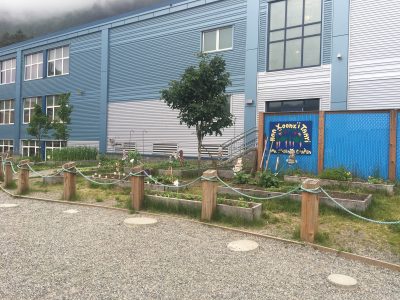LEARNING FROM THE GROUND UP
Some of the best gardeners are children. They bring a curiosity and excitement unmatched by the grown garden enthusiast. Most schools have started gardening and composting programs allowing students hands on experience. I work for an after school program called Rally in Juneau, Alaska. One of Rally’s sites is at Harborview elementary and lucky for us they have gardening beds and a composting site on the school grounds. Rally has incorporated the gardens in its summer program to help keep them maintained when school is not in session. The first week of summer, Rally was all about soil.
When starting a garden, most gardener’s begin with determining soil content. Students can learn about their world from the ground up using this lesson in soil science.

SOIL SCIENCE
Determining Soil Type and Function
(Grades 2-5)
The lesson is ideal for early spring after the last frost but can be performed throughout the year with the exception of winter when the ground is still frozen. This lesson is very versatile and can be an easy thirty minutes or spread out over a few day period.
By the end of this lesson students should be able to list aspects of soil composition, recognize that soils vary in composition, and describe how plants obtain nutrients from the soil.
To begin the lesson, open up a discussion with students by asking them “What is soil?” A great way to spark answers among students is to have some dirt handy. Let them feel and even smell the soil. For the tech savvy teacher a good power-point or short video on soil soil science would be a great introduction for this hands-on activity. Here is a link to a very short and descriptive video on youtube. This web site has great links to other lesson plans and material relevant to soil science.
When discussing soil with students talk about the key make-up of soil: minerals, water, air and organic matter. Talk about and discuss the functions of soil. Soil is the “Skin of the Earth”. Share with students the essential role soil plays in our world.
1. Soils support plant growth.
2. Soils modify the atmosphere by absorbing and emitting gases (carbon dioxide, methane, water vapor).
3. Soils provide habitats for organisms. (FUN FACT: A handful of soil has more living organisms in it than the entire population of the world!)
4. Soils hold, absorb, purify and alter water in terrestrial systems.
5. Soils process and recycle nutrients so living things can re-use them over and over
This website provides some activity worksheets teachers can utilize to help in soil discussion.
Now after all the talking and paperwork, it’s on to the fun stuff.
SOIL TEXTURE ANALYSIS
Materials:
Glass Jars
Soil Samples
Marking Pen
Water
- Collect soil samples. This can be done as a class to obtain a few samples or students can each bring in samples from home. Let samples air dry for a day.
- Fill jar half full of soil.
- Fill the rest of the jar with water and shake vigorously.
- After one minute mark the depth of soil. This is the amount of sand.
- After 2 hours mark the depth of soil again. This is the depth of the silt.
- When the water completely clears, mark the depth again. This is the depth of the clay.
- Measure and record the thickness of each layer.
- Use the measurements to calculate the percentages of each layer.
- Clay thickness ÷ Total thickness= Clay %
- Silt thickness ÷ Total thickness = Silt %
- Sand thickness ÷ Total thickness = Sand %
- Use the Soil Triangle to determine soil type.
Students enjoy this activity. It gets students out of the classroom and gives them opportunity to dig around in some dirt. This lesson also segues easily into plants and plant development and can be used as the foundation for starting a classroom garden.